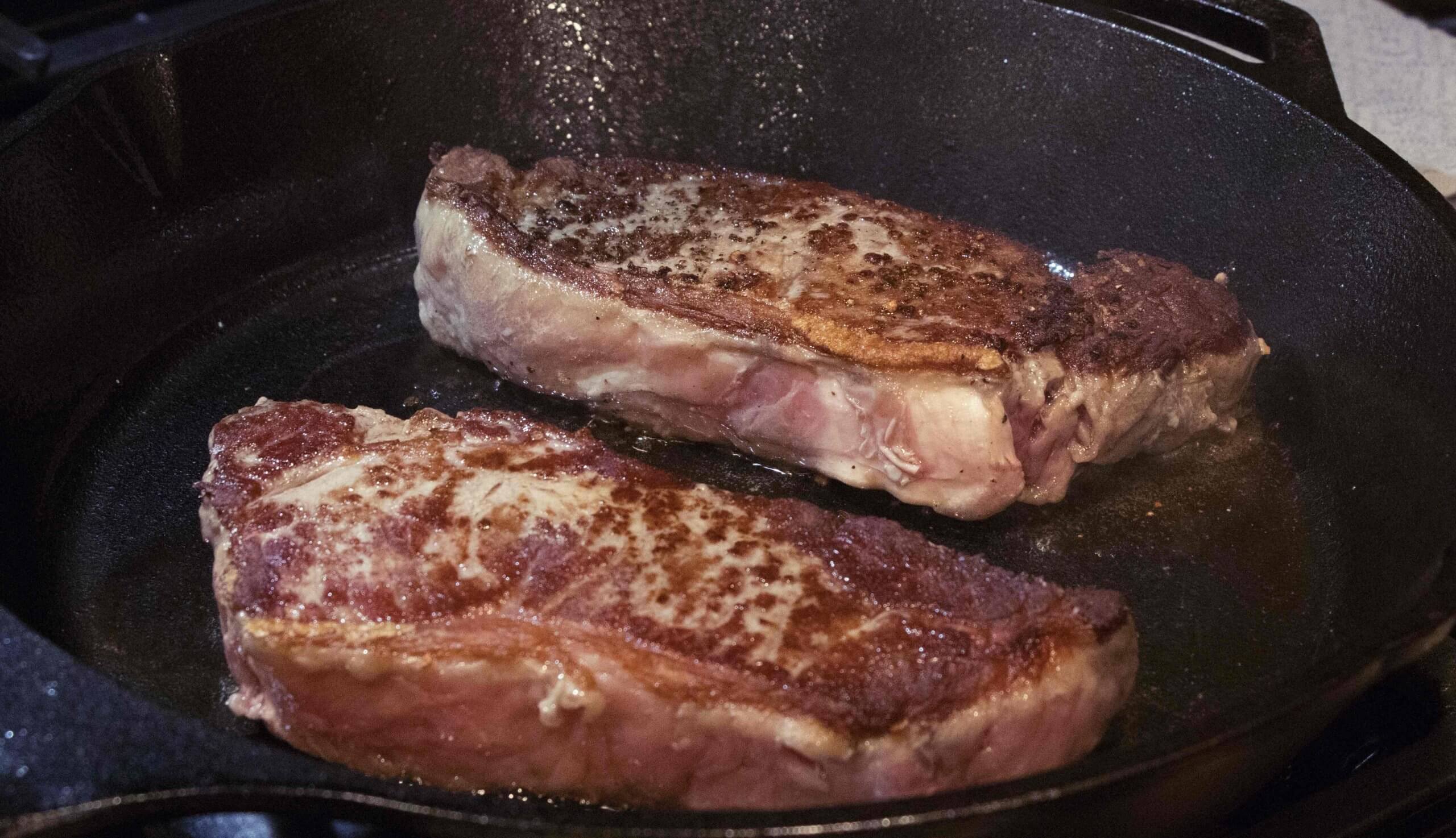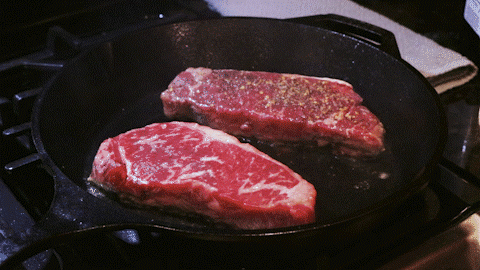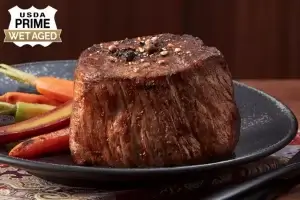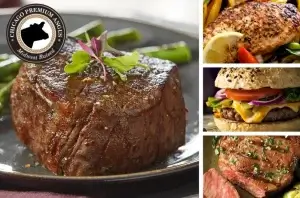
One of the qualities that we at Steak University love most about a gourmet Chicago Steak Company steak is its versatility and ability to accommodate various cooking styles. From the outdoor BBQ to indoor stovetop grills, a high quality, gourmet steak, such as those found at MyChicagoSteak.com, will retain maximum flavor and moisture as long as you stick to a couple of basic principles regarding seasoning and internal temperature.
The best part about starting with high-quality gourmet steaks is that you don’t need a lot of extra kitchen gadgets to get a perfectly cooked steak every time. In fact, sometimes simplicity is best and one of our favorite tried and true methods for no-fuss meaty goodness is pan fried steak. All you need to whip up this easy steak recipe is one run-of-the-mill steak pan and a couple of steaks in the cut of your choice. If we’ve piqued your interest and you want to learn more about this easy, one pan, steak cooking method, keep reading. We have all the details you need to get you frying steak like a pro in no time.
Table of Contents
Steak Cuts for Pan Fried Steak
With so many beef cuts available for you to enjoy, how do you know which beef is the best for your pan fried steak? In most cases, a boneless cut of beef is best because they’re quicker to cook and usually cook more evenly. With that said, you can still make a bone-in cut work for pan frying that’s your preference.
Here are some of our favorite options for this particular steak recipe and cooking method:
Ribeye Steak
Rib eye steak is a favorite for its texture and flavor. This cut is super beefy, so steak enthusiasts will definitely appreciate its taste. It’s common to find ribeye in steakhouses for this very reason. Ribeye steak stays very tender as it cooks because of the fat that runs through it. As the meat cooks, the fat renders down, transferring flavor throughout the steak and leaving it easy to chew.
As for pan frying, ribeye is one of the best cuts to choose because when it gets a sear, it tastes even better (if that’s possible!). Ribeye is also a thick cut, allowing it to get nice and crisp on the outside when pan frying, while remaining juicy and tender on the inside.
Flat Iron Steak
If you’re looking for a quick cook on the stove, then flat iron steak is ideal. This steak cut is thinner than others, so you’ll need to stand by it to monitor while to cooks. Still, its thinness also makes it convenient to cook when you’re in a rush and don’t have much time to fuss with dinner. It’s also a popular cut for grilled steak for this reason.
Keep the flat iron steak intact while you cook it and slice it after allowing it to rest for 5-10 minutes. You can use flat iron steak for steak sandwiches, stir fry, or on its own. You can also marinade this steak in the refrigerator for a few hours before cooking it to tenderize and flavor it.
Filet Mignon
Filet mignon is one of the thickest steak cuts, so it can be tricky to perfect with a pan-seared cook. However, if you’ve already made pan fried steak with other cuts, you might want to try your hand at this fabulous cut of steak. By nature, filet mignon doesn’t have as much beefy flavor as other cuts, but its tenderness is what helps it stand out. When cooked correctly, you should barely need to chew filet mignon pieces.
When cooked in a pan, you can give filets an incredible sear, which just adds to its overall texture and gives it a more robust, savory flavor. The ideal cook for filet mignon is medium-rare, which you can usually achieve by cooking it for a few minutes on each side in the pan. If you like a medium or medium-well filet, you might need to transfer your steak to the oven for a few more minutes to allow more cooking in the middle.
Strip Steak
Boneless strip steak is an excellent option for pan frying. This cut comes from the short loin and is flavorful and tender. It often rivals the ribeye with steak enthusiasts and is another favored cut you’ll find in most steakhouses. However, if tenderness is your priority, you’ll find that strip steak doesn’t have the same soft texture as ribeye, so you’ll need to use a bit more care to avoid overcooking it and drying it out.
As a thicker steak, it does well when cooked in a pan. You can sear your strip steak for 4-5 minutes on each side, setting the temperature to low afterward if you still need the inside to cook a bit more for your desired doneness.
Sirloin
The sirloin steak comes from the same area as the porterhouse and T-bone. This cut is close to the rear of the cow, meaning that it gets exercised quite a bit and tends to be a little tougher than other cuts. However, it’s also very lean, making it a good option for those trying to cut some fat from their diet.
You can buy bone-in or boneless sirloin, and either one works for pan frying. However, we do recommend choosing top sirloin rather than bottom sirloin. Bottom sirloin is usually the more affordable cut, but it’s not as tender as top sirloin.
Porterhouse or T-Bone
Porterhouse and T-bone steaks are similar, but porterhouse cuts are larger than T-bone. Both include a tenderloin on one side of the bone and strip steak on the other, but the tenderloin portion is larger on a porterhouse. These cuts are excellent on the grill, but we also find that pan frying them is a good alternative option for indoor cooking.
Also, don’t forget to pair your steak with a refreshing beer. Check out this guide for pairing your beer with the best steak cut.
The Best Pan for Frying Steak
Before we get to the meat itself, we should first devote a few words to steak pan selection. Walking into your local home supply store you may find yourself overwhelmed with the number of options when it comes to frying pans, like non-stick vs cast-iron vs aluminum vs copper. From surface construction to material composition, the choices can seem unending.
Don’t shell out a ton of dough for that high end, diamond plated, titanium infused contraption just yet. Good pans for frying steak have a few common characteristics, regardless of price or brand. First, stay away from non-stick surfaces. While there are quality models out there that are perfect for whipping up your morning eggs, there is just no way to get a good pan seared steak on a non-stick surface.
Next, you want a pan with some heft as weightier pans tend to retain heat better and produce a more even cooking temperature. A cast iron skillet is perfect for the job, as it’s heavier than most pans and it attracts heat well, leaving a crispy crust on your steak. While we prefer a nice, thick, well-seasoned cast iron pan for the job, there are a number of variations in material and construction that will get you frying steak like a pro if you follow these basic principles.
In conclusion, consider paying more for quality when it comes to pan frying a steak. Skimping on quality to save money will end up costing you money in the long run when you spend top dollar on steaks that you can’t cook to perfection.
How to Cook a Pan Fried Steak
Now, let’s get to preparing, cooking, and finishing a pan fried steak that you’ll be happy to show off at the dinner table.
Preparing to Cook the Perfect Pan Seared Steak
After you’ve selected a quality steak pan, you’ll want to prep both it and your steak for cooking. Before doing anything to your steak, remove it from the refrigerator and keep it at room temperature for about ½ an hour. This resting period gives your steak time to come down slightly in temperature for a more even cook.
PRO TIP: If you forgot to thaw your steak in advance, check out our guide for ways to cook frozen steak.
While quality, gourmet steaks require little in the way of fuss, you have the option of changing things up and adding interesting flavor profiles with spices and seasonings at this stage. Before adding anything to your steak, be sure to use a paper towel to remove any moisture from all sides of the steak. Doing so will allow it to crisp up in the pan.
We’ve written before about steak sauces and seasonings, but frying steak is also a great opportunity to try out a little dredge action for extra crust and crunch. To give this easy steak recipe a go, try mixing up a little flour, paprika, garlic powder, salt and pepper and apply a quick dusting to both sides of your steak before placing in the pan. You can also go simple and classic with some kosher salt, black pepper, and maybe a little bit of thyme rubbed into the steak on all sides.
Oil, Season and Cook
Now, it’s time to heat up your pan. Add compound butter or olive oil to the pan and heat it over medium-high heat. Once the pan is thoroughly heated, you can add your steak to the pan, releasing them in the direction away from you to avoid splatters. Then, leave the steaks in the pan to cook for 3-5 minutes on each side until a crispy golden-brown crust forms. Flip to the other side and wait another 3-5 minutes until you see a crust.
As a tasty and flavorful bonus, after removing your steak from the pan to rest, deglaze with beef stock, red wine or a combination of both for a quick and easy gravy or a base for a delicious pan sauce. This pan sauce adds even more flavor and juiciness to your steak when you’re ready to serve it.
Whether you choose to dredge, season or leave bare, be sure to use plenty of butter or oil in your steak pan and to pre-heat your pan prior to adding the steak. A good rule of thumb is that a small drop of water should sizzle and pop when dropped into a pan hot enough to properly sear a steak. After that, cook 3-5 minutes per side to reach your appropriate level of doneness, then move on to finishing your steak.
Finishing Your Pan Seared Steak
Continuing with our theme of versatility, a pan fried or pan seared steak has a variety of cooking and flavoring options to finish things off. In the past, we’ve mentioned our easy steak recipe that calls for finishing the cooking process in a pre-heated oven. This might be necessary if you’ve already achieved the perfect crust on both sides of your steak, but its internal temperature hasn’t yet reached your desired doneness level. If you’re using a cast iron skillet, you can place the whole thing into the oven for a few minutes to cook the inside some more. If using a regular frying pan, you’ll need to transfer your steaks to an oven-safe pan first.
At the finishing stage, you can also top with a pad of butter, garlic, or some combination of both, to boost the richness and compliment the natural meaty flavors of your steak. A drizzle of melted butter with garlic or your pan sauce can also do wonders for a juicy steak. No matter if you finish in the oven or stove-top or choose to garnish with butter or not, don’t forget to remove your steak from the heat and allow to rest for 3-5 minutes prior to serving. This will allow time for the juices of your gourmet steak to congeal and will keep them on the inside where they should be when you cut in for your first bite.

Temperatures for the Perfect Pan Fried Steak
One area that pan frying falls short in is its ability to get an even cook throughout the meat. This cooking method really is best for those who prefer a medium-rare cook, as it’s difficult to get the internal temperature to a medium doneness without burning the outsides of the steak.
To help the inside of the steak reach your desired temperature, you can turn the burner’s heat to low and cover the pan after you’ve seared your steak. Allow the steak to cook for another 2-3 minutes. Read our guide to steak temperatures for more help getting the perfect cook.
Reheating Leftover Pan Fried Steak
After you cook steak, it can sometimes be a challenge to preserve when you reheat it. Leftover steak is something you certainly don’t want to waste, though!
To reheat your leftover steak, we recommend the following method:
- Heat a small amount of olive oil in the same pan you used to cook the steak originally over medium-high heat.
- Turn the heat to low-medium before placing the steak in the pan.
- Cover the pan with a lid and cook for 4-6 minutes, or until the inside reaches your desired temperature with a meat thermometer.
- As usual, allow the steak to rest for 5 minutes out of the pan before serving.
Avoid using the oven or microwave, if possible, to prevent your steak from drying out.
The Final Steak U Word on Frying Steak
As you can see, there are a number of options for cooking up a gourmet pan fried steak. As with other cooking methods, seasonings and finishing can give an easy steak recipe your own, unique spin. Experiment with a few family favorite flavor profiles to find the recipe that fits your palette the best. Have a recipe in mind that you know is a sure winner? Email us at Steak University and maybe we’ll feature it in an upcoming future article. Until then, remember that whether grilled, BBQ’ed or pan fried, there is no wrong way to enjoy your high quality, gourmet steaks from the Chicago Steak Company.



